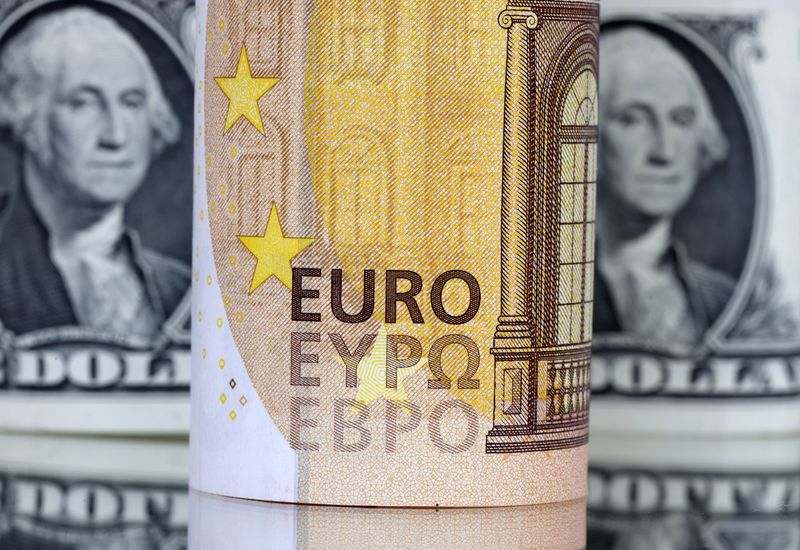By Gertrude Chavez-Dreyfuss
NEW YORK (Reuters) - The safe-haven dollar and yen rose on Tuesday as market sentiment turned risk-averse amid renewed worries about the banking sector and the outlook for the global economy, which knocked the euro off a nearly 10-month high.
The U.S. dollar index climbed 0.6% to 101.83, having dropped more than 4% since March 8.
"Lower risk appetite is clearly the main driver here for the dollar and for other havens as well," said Shaun Osborne, chief FX strategist, at Scotiabank in Toronto.
"But we're not really breaking out in the dollar or extending significantly at this point. This is not a longer-term development, so we have to look at opportunities to fade the dollar rally," he added.
A weak consumer confidence report and a decline in Federal Reserve manufacturing data further added to the dollar's and yen's safe-haven appeal.
Data showed U.S. consumer confidence fell to a nine-month low in April, a survey showed on Tuesday. The Conference Board said its consumer confidence index fell to 101.3 - the lowest since July 2022 - from a revised 104.0 in March.
The U.S. Richmond Fed manufacturing index slid as well, down at -10 in April, the fourth straight month of contraction.
Both surveys negated strong U.S. housing data, which showed new home sales beat estimates with a 9.6% rise in March to a one-year high of 683,000 after net revisions.
"The bias is for dollar weakness, but I think until U.S. data weakens substantially, it's hard to see that trend really picking up," said Vassili Serebriakov, FX strategist at UBS in New York.
News on Monday of plunging deposits at First Republic Bank served as a reminder that stability risks have not entirely died down, while UBS reported a 52% slide in quarterly income.
The yen firmed, behaving like a typical safe haven, even as the Bank of Japan's (BOJ) new governor Kazuo Ueda signaled he was not in a hurry to shift policy. This week's BOJ meeting, which concludes on Friday, is his first in charge.
The Japanese currency rose 0.6% to 133.495 per dollar and was up 1.2% at 146.42 per euro, having earlier touched an eight-year low of 148.635.
(Graphic: Performance versus dollar - https://fingfx.thomsonreuters.com/gfx/mkt/lbpggzbjlpq/Pasted%20image%201682416690202.png)
The euro dropped 0.7% against the dollar to $1.0969, having risen 1.2% so far in April and more than 4% since mid-March.
ECB board member Isabel Schnabel told Politico that a 50 basis point (bp) rate hike was not off the table and would depend on data - notably inflation figures due two days before May's meeting.
Elsewhere, sterling was down 0.6% at $1.2403, but was close to a 10-month high of $1.2545 reached earlier this month.
The Australian dollar dropped 1.1% to US$0.6621 as traders waited for inflation data due on Wednesday, while the New Zealand dollar was at US$0.6138, down 0.5%.
========================================================
Currency bid prices at 4:10PM (2010 GMT)
Description RIC Last U.S. Close Pct Change YTD Pct High Bid Low Bid
Previous Change
Session
Dollar index 101.8300 101.2500 +0.58% -1.604% +101.9500 +101.1900
Euro/Dollar $1.0973 $1.1046 -0.65% +2.42% +$1.1068 +$1.0965
Dollar/Yen 133.6150 134.2550 -0.49% +1.90% +134.4550 +133.3600
Euro/Yen 146.61 148.26 -1.11% +4.50% +148.6100 +146.3000
Dollar/Swiss 0.8919 0.8876 +0.50% -3.53% +0.8927 +0.8862
Sterling/Dollar $1.2407 $1.2483 -0.60% +2.60% +$1.2507 +$1.2388
Dollar/Canadian 1.3629 1.3541 +0.66% +0.60% +1.3647 +1.3525
Aussie/Dollar $0.6624 $0.6696 -1.09% -2.84% +$0.6705 +$0.6614
Euro/Swiss 0.9786 0.9805 -0.19% -1.10% +0.9815 +0.9777
Euro/Sterling 0.8843 0.8844 -0.01% -0.01% +0.8876 +0.8841
NZ $0.6140 $0.6167 -0.45% -3.31% +$0.6187 +$0.6133
Dollar/Dollar
Dollar/Norway 10.6850 10.5280 +1.43% +8.81% +10.7020 +10.5200
Euro/Norway 11.7293 11.6267 +0.88% +11.77% +11.7366 +11.6066

Dollar/Sweden 10.3121 10.2371 -0.04% -0.92% +10.3266 +10.2274
Euro/Sweden 11.3110 11.3156 -0.04% +1.45% +11.3435 +11.2934